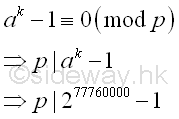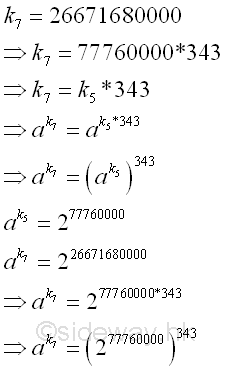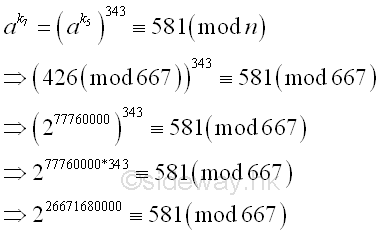Content
Pollard's p-1 Method
Pollard's P-1 Methed by Smooth Number
Pollard's P-1 Methed by Smooth Number Example 2
Pollard's p-1 Method
Pollard's p-1 method is a prime factorization algorithm discovered by John Pollard in 1974. Limited by the algorithm, the Pollard's p-1 method is only work for integers with specific factors.
If the number n has a prime factor p such that p-1 can be expressed in terms of a product of primes, the finding of prime factor p is based on the selected boundary B of the B-smooth number. The algorithm fails when the selected boundary B is smaller than the B-smooth number of p-1.
Pollard's P-1 Methed by Smooth Number
Pollard's P-1 Methed by Smooth Number Example 2
For example: n=667=p*q=23*29; let B=5 imply
| Integer | B-smooth number | Prime Factors | number |
|---|---|---|---|
| k | 5 | 29*35*54 = 512*243*625 | 77760000 |
Therefore for B=5, k5 or (p5-1)m5 is equal to 77760000.
Fermat's Little Theorem
let a=2, by Fermat's little theorem, let p be one of the prime factors of n, imply p idivides ak-1.

Greatest Common Divisor
Since ak-1 is a very large number, before finding the greatest common divisor of n and ak-1, ak-1 can be raised to the high power modulo n. Imply
Using squarings modulo
| base | number; a=2; k=77760000; n=667 |
|---|---|
| ak base 10 | 21296000 |
| ai base 10 | 21 = 21 ≡ 2 (mod 667) |
| 22 = 22 ≡ 4 (mod 667) | |
| 24 = 42 ≡ 16 (mod 667) | |
| 28 = 162 ≡ 256 (mod 667) | |
| 216 = 2562 ≡ 170 (mod 667) | |
| 232 = 1702 ≡ 219 (mod 667) | |
| 264 = 2192 ≡ 604 (mod 667) | |
| 2128 = 6042 ≡ 634 (mod 667) | |
| 2256 = 6342 ≡ 422 (mod 667) | |
| 2512 = 4222 ≡ 662 (mod 667) | |
| 21024 = 6222 ≡ 25 (mod 667) | |
| 22048 = 252 ≡ 625 (mod 667) | |
| 24096 = 6252 ≡ 430 (mod 667) | |
| 28192 = 4302 ≡ 141 (mod 667) | |
| 216384 = 1412 ≡ 538 (mod 667) | |
| 232768 = 5382 ≡ 633 (mod 667) | |
| 265536 = 6332 ≡ 489 (mod 667) | |
| 2131072 = 4892 ≡ 335 (mod 667) | |
| 2262144 = 3352 ≡ 169 (mod 667) | |
| 2524288 = 1692 ≡ 547 (mod 667) | |
| 21048576 = 5472 ≡ 393 (mod 667) | |
| 22097152 = 3932 ≡ 372 (mod 667) | |
| 24194304 = 3722 ≡ 315 (mod 667) | |
| 28388608 = 3152 ≡ 509 (mod 667) | |
| 216777216 = 5092 ≡ 285 (mod 667) | |
| 233554432 = 2852 ≡ 518 (mod 667) | |
| 267108864 = 5182 ≡ 190 (mod 667) | |
| ak base 10 | 267108864+8388608+2097152+131072+32768+1024+512 |
| ak base 10 | 267108864*28388608*22097152*2131072*232768*21024*2512 |
| ak base 10 | 190*509*372*335*633*25*662 ≡ 426 (mod 667) |
and using the residue to calculate the greatest common divisor. Imply

The greatest common divisor of n and ak-1 is
Using Euclid's algorithm
| ak-1 | n |
|---|---|
| 277760000-1 | 667 |
| 426-1 | 667 |
| 425 | 667-425=242 |
| 425-242=183 | 242 |
| 183 | 242-183=59 |
| 183-3*59=6 | 59 |
| 6 | 59-9*6=5 |
| 6-5=1 | 5 |
| 1 | 5-5*1=0 |
| 1 | 0 |
Imply

The algorithm fails because the greatest common divisor of n and ak-1 is equal to 1. The number n does not have prime divisor p with p-1 is 5-smooth. Therefore the bound B equals to 5 fails, a larger bound B' should be used.
Let B=7, imply
| Integer | B-smooth number | Prime Factors | number |
|---|---|---|---|
| k | 7 | 29*35*54*73 = 512*243*625*343 | 77760000 * 343 = 26671680000 |
Therefore for B=7, k7 or (p7-1)m7 is equal to 77760000*343 = 26671680000. Imply k7 = k5 * 343. And the new ak can be expressed as

And ak can be raised to the high power modulo n, imply

Using squarings modulo
| base | number; a=426; k=343*; n=667 |
|---|---|
| ak base 10 | 426343 (mod 667) |
| ai base 10 | 4261 = 4261 ≡ 426 (mod 667) |
| 4262 = 4262 ≡ 52 (mod 667) | |
| 4264 = 522 ≡ 36 (mod 667) | |
| 4268 = 362 ≡ 629 (mod 667) | |
| 42616 = 6292 ≡ 110 (mod 667) | |
| 42632 = 1102 ≡ 94 (mod 667) | |
| 42664 = 942 ≡ 165 (mod 667) | |
| 426128 = 1652 ≡ 545 (mod 667) | |
| 426256 = 5452 ≡ 210 (mod 667) | |
| 426512 = 4222 ≡ 662 (mod 667) | |
| ak base 10 | 426256+64+16+4+2+1 (mod 667) |
| ak base 10 | 426256*42664*42616*4264*4262*4261 (mod 667) |
| ak base 10 | 210*165*110*36*52*426 ≡ 581 (mod 667) |
and using the residue to calculate the greatest common divisor. Imply

The greatest common divisor of n and ak-1 is
Using Euclid's algorithm
| ak-1 | n |
|---|---|
| 226671680000-1 | 667 |
| 581-1 | 667 |
| 580 | 667-580=87 |
| 580-6*87=58 | 87 |
| 58 | 87-58=29 |
| 58-2*29=0 | 29 |
| 0 | 29 |
Imply

Integer 29, the greatest common divisor of n and ak-1 is also the prime divisor of n. And p-1 is 7-smooth.
| Integer | B-smooth number | Prime Factors | number |
|---|---|---|---|
| p-1 | 7 | 22*71 | 28 |
| k | 7 | 29*35*54*73 = 512*243*625*343 | 26671680000 |
| k/(p-1) | 27*35*54*72 | 952560000 |
©sideway
ID: 120500006 Last Updated: 5/15/2012 Revision: 0
Latest Updated Links
- Rampage II Extreme(last updated On 8/23/2023)
- AVerMedia Live Gamer HD 2 - GC570(last updated On 7/16/2023)
- MagicPro ProHDTV(last updated On 7/15/2023)
- ROG STRIX Z690-A GAMING WIFI D4 CPU, BIOS, Chipset(last updated On 7/15/2023)
- Intel Core Processor(last updated On 7/14/2023)
- AVerMedia Live Gamer HD 2 - GC570(last updated On 7/13/2023)
- R2E Document(last updated On 7/11/2023)
- R2E Driver and Utility(last updated On 7/10/2023)
- R2E CPU, BIOS, Chipset(last updated On 7/9/2023)
- ASRock X58 Deluxe(last updated On 7/8/2023)
- ASRock X58 Deluxe(last updated On 7/7/2023)

 Nu Html Checker
Nu Html Checker  53
53  na
na  na
na
Home 5
Business
Management
HBR 3
Information
Recreation
Hobbies 8
Culture
Chinese 1097
English 339
Reference 79
Computer
Hardware 249
Software
Application 213
Digitization 32
Latex 52
Manim 205
KB 1
Numeric 19
Programming
Web 289
Unicode 504
HTML 66
CSS 65
SVG 46
ASP.NET 270
OS 429
DeskTop 7
Python 72
Knowledge
Mathematics
Formulas 8
Algebra 84
Number Theory 206
Trigonometry 31
Geometry 34
Calculus 67
Engineering
Tables 8
Mechanical
Rigid Bodies
Statics 92
Dynamics 37
Fluid 5
Control
Acoustics 19
Natural Sciences
Matter 1
Electric 27
Biology 1
